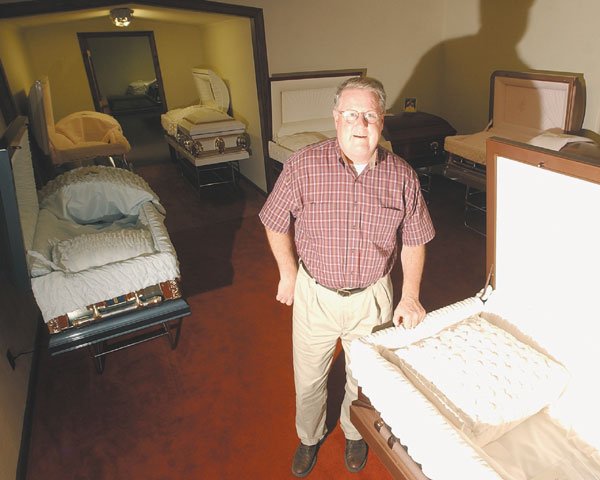John Sander was going to be a teacher, but even right out of
college, he knew it wasn’t the job for him.
That’s when a friend of the family who owned a funeral home
suggested something he may be good at: working in the mortuary.
John Sander was going to be a teacher, but even right out of college, he knew it wasn’t the job for him.
That’s when a friend of the family who owned a funeral home suggested something he may be good at: working in the mortuary.
“I kind of, in the back of my mind, had thought of it,” said Sander, who owns and operates Black-Cooper-Sander Funeral Home in Hollister with his two sons. “People tell me that (it takes a certain type of person to do this), but I don’t feel any different than anyone else. It’s a job I can do. I don’t like working with dead people, but I don’t mind it, and I don’t wake up in the morning worrying about being unemployed.”
Morticians like Sander fulfill a dual purpose in death, preparing the body of a person’s loved one and, in many ways, preparing the family of the departed to face the death. These roles require both emotional warmth and calculated distance for embalmers and funeral directors.
Though this series has delved into the lives of coroners, crime scene cleaners and medical examiners, it is actually morticians who respond to the greatest number of calls for dead bodies. They pick up newly deceased people from hospitals, nursing homes and residences, since many people do die under the care of doctors or relatives and are nearly immediately found, according to John Ander, a funeral director for Habing Family Funeral Home in Gilroy.
When called, an embalmer – a specially trained mortuary counselor who is certified in embalming – usually picks up the body and returns it to the mortuary to await preservation or refrigeration. Embalming is still a very popular service – half or more of clients select the procedure on the West Coast – but it is not required by the state of California, so a variety of options are available, said Ander.
If a person is to be cremated or buried in a closed-casket funeral, he or she does not need to be embalmed, but most morticians specify that bodies exhibited in open-casket funerals must be preserved.
“This is a sensitive business, and it’s an image that we don’t want to put out there,” said Sander. “Unembalmed bodies can purge – their stomach contents can come out of the mouth and nose. They might be discolored or smell. That’s the last thing you want people saying about your business – ‘Nice funeral, but man, did you see the body?’ Recidivism, like in any industry, is important to us.”
Embalming fluid, makeup and presentation all work together to make a body firm, full and aesthetically pleasing during an open-casket funeral, but the first step is positioning, according to Ander.
First, embalmers “set the features” of a person, placing textured disks under a man or woman’s eyelids to keep the eyes closed, and suturing or wiring the mouth shut in as realistic a pose as possible. Then, they position the body.
“You want to make sure you’ve got them where you want them,” said Ander. Then, setting his arms askew over his head, “If you embalm someone like this, that’s how they’re going to stay.”
The embalming process itself is relatively straightforward in most cases. Embalmers insert a tube into the carotid artery, pushing a formaldehyde solution into the blood vessels through the heart’s main send-off point and pushing the body’s blood out of a tube attached to the jugular vein, the body’s return system for blood.
Embalming usually takes about 1 1/2 to 2 hours, but it can take longer if the decedent had poor circulation or an autopsy.
“In someone who’s been autopsied, there’s really no central area to embalm from, so we do what’s called a six-point injection for the fluid,” said Ander. “You have to find both femoral arteries in the legs and inject them, find the ancillary arteries in the arms and find the carotids in the jaw and do the same. For the rest of the organs, you have to open everything back up and treat the bagged material, too.”
A few problems can crop up during the embalming process. For instance, a jaundiced person’s body can turn green, said Ander, or someone who lost a large amount of weight right before death may smooth out and look too young. Some people’s skin also dries out.
“The embalming process will dry out the skin if you use too much, so you use some special cream – we use Kalon cream – to rehydrate.”
The next process is makeup. Some bodies come out of the embalming process with relatively true skin tones, despite the difficulty of maintaining natural skin coloration after blood is removed. These are the bodies on which morticians can use regular retail make-up on, but others aren’t so lucky. When a person dies, the blood settles in the side of the body closest to the ground. Thus, if the person fell face-down and laid there for a day or more, he or she may have suffered from some coagulation and swelling in the face, said Sander.













